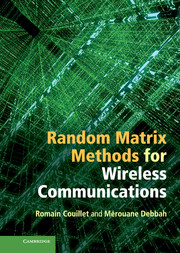Book contents
- Frontmatter
- Contents
- Preface
- Acknowledgments
- Acronyms
- Notation
- 1 Introduction
- Part I Theoretical aspects
- 2 Random matrices
- 3 The Stieltjes transform method
- 4 Free probability theory
- 5 Combinatoric approaches
- 6 Deterministic equivalents
- 7 Spectrum analysis
- 8 Eigen-inference
- 9 Extreme eigenvalues
- 10 Summary and partial conclusions
- Part II Applications to wireless communications
- References
- Index
9 - Extreme eigenvalues
from Part I - Theoretical aspects
Published online by Cambridge University Press: 07 October 2011
- Frontmatter
- Contents
- Preface
- Acknowledgments
- Acronyms
- Notation
- 1 Introduction
- Part I Theoretical aspects
- 2 Random matrices
- 3 The Stieltjes transform method
- 4 Free probability theory
- 5 Combinatoric approaches
- 6 Deterministic equivalents
- 7 Spectrum analysis
- 8 Eigen-inference
- 9 Extreme eigenvalues
- 10 Summary and partial conclusions
- Part II Applications to wireless communications
- References
- Index
Summary
This last chapter of Part I introduces very recent mathematical advances of deep interest to the field of wireless communications, related to the limiting behavior of the extreme eigenvalues and of their corresponding eigenvectors. Again, the main objects which have been extensively studied in this respect are derivatives of the sample covariance matrix and of the information plus noise matrix.
This chapter will be divided into two sections, whose results emerge from two very different random matrix approaches. The first results, about the limiting extreme eigenvalues of the spiked models, unfold from the previous exact separation results described in Chapter 7. It will in particular be proved that in a sample covariance matrix model, when all population eigenvalues are equal but for the few largest ones, the l.s.d. of the sample covariance matrix is still the Marčenko–Pastur law, but a few eigenvalues may now be found outside the support of the l.s.d. The second set of results concerns mostly random matrix models with Gaussian entries, for which limiting results on the behavior of extreme eigenvalues are available. These results use very different approaches than those proposed so far, namely the theory of orthogonal polynomials and determinantal representations. This subject, which requires many additional tools, is briefly introduced in this chapter. For more information about these tools, see, e.g. the tutorial [Johnstone, 2006] or the book [Mehta, 2004].
- Type
- Chapter
- Information
- Random Matrix Methods for Wireless Communications , pp. 223 - 242Publisher: Cambridge University PressPrint publication year: 2011



